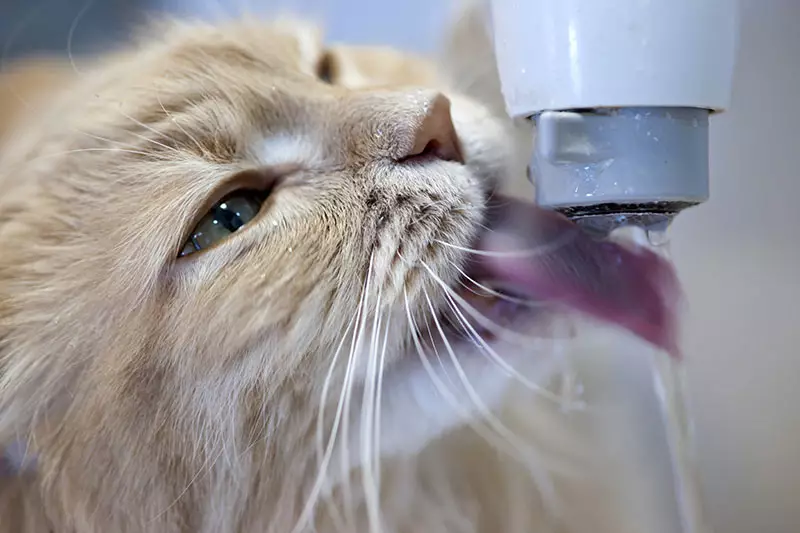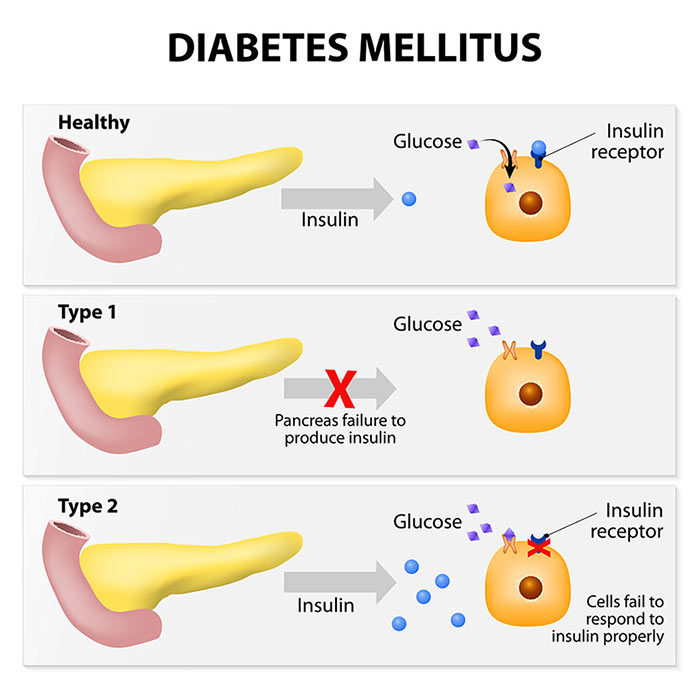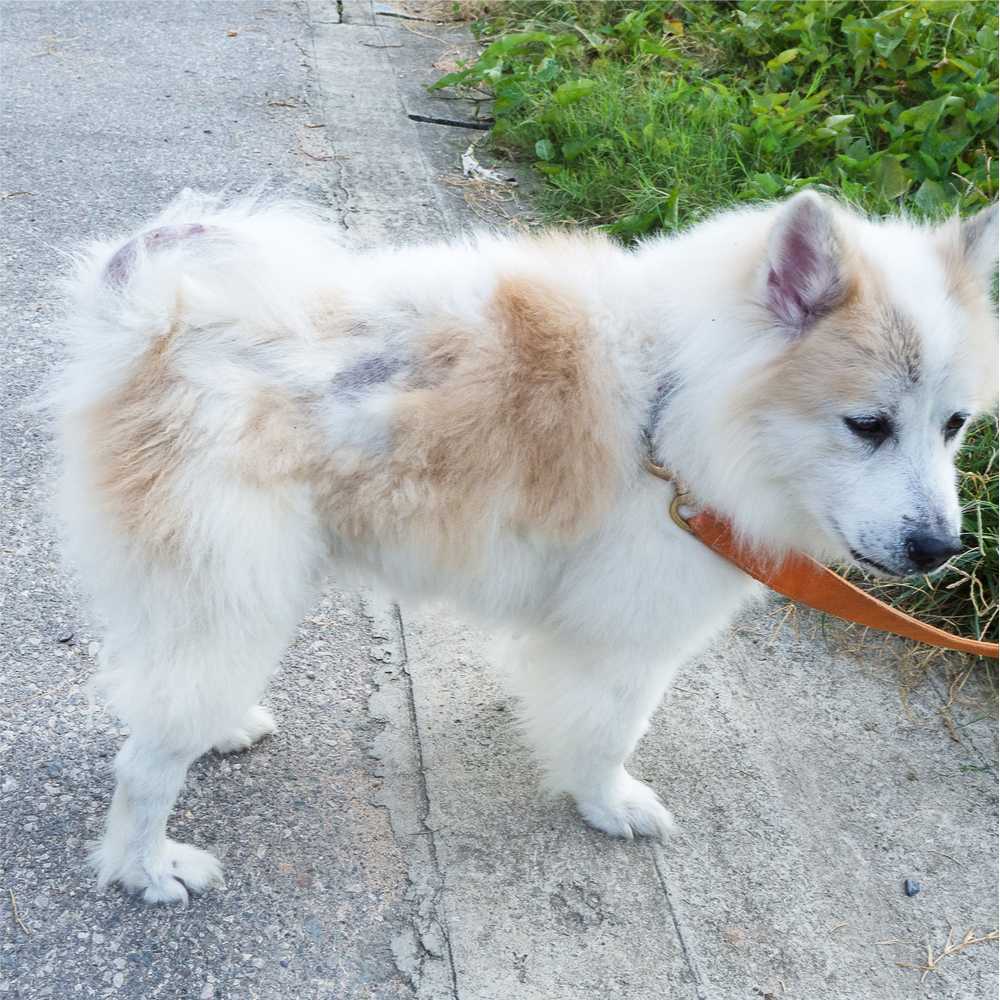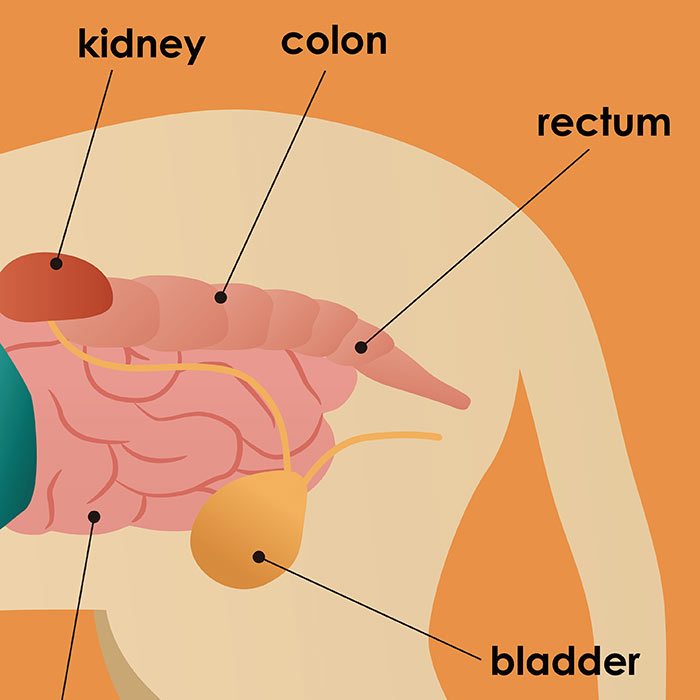Polyuria and Polydipsia in dogs and cats
What are polyuria and polydipsia?
“Poly-“ used as a prefix means much or many. Polyuria is abnormally high urine production, and polydipsia is increased level of thirst. In animals, Polydipsia is demonstrated by excessive water intake and polyuria by excessive urination. These conditions commonly occur together. Polydipsia, excessive drinking, can lead to polyuria, the production of a large volume of urine. Conversely, polyuria (excessive urination) can lead to polydipsia (excessive drinking). Polyuria and polydipsia are commonly abbreviated as “PU/PD”.
Polyuria and polydipsia in dogs and cats are frequent presenting complaints in veterinary practices. They may occur as primary or secondary conditions and can be indicative of a potentially serious underlying medical disorder. Therefore, animals that drink excessively and/or urinate excessively require further investigation to determine the cause of their disordered water intake and/or output.
Polyuria – excessive urination
In dogs, normal urine production is estimated to be 20 to 40 ml per kilogram of body weight per day (or 1-2 ml/kg/hour). Polyuria is defined as a daily urine output of greater than 50 ml/kg/day. In cats, a study has found that normal adult cats produced an average of 28 ml of urine per kilogram of body weight per 24 hours (source). Urine volume in excess of 40 ml/kg/day in cats is defined as polyuria.

Polydipsia – excessive thirst
Healthy dogs generally take in between 50 to 60 ml of fluids per kilogram of body weight per day, depending on the moisture content of their diets, their level of activity and the weather conditions. In dogs, polydipsia is defined as a fluid intake of more than 100 ml per kilogram of body weight per day (i.e., double what is considered necessary). Cats normally take in up to 45 ml of liquid per kilogram of body weight per day; anything more than 50 ml/kg/day is probably excessive and indicative of polydipsia, under normal environmental conditions.

Types
The balance between the water intake and water loss in the body is governed by interactions between the hypothalamus, the pituitary gland and the kidneys, and is maintained by thirst and renal excretion of water and salts. Depending on the body’s need to conserve or eliminate water and salts, PU/PD may be a normal (physiologic or compensatory) response or an abnormal (pathologic) response.
Primary polyuria: This is a disorder of water balance caused by the inability of the kidneys to conserve water. In the case of primary polyuria, polydipsia is a compensatory mechanism to maintain total body fluids within normal limits.
Physiologic polyuria: This usually occurs as a compensatory response to increased fluid intake, where polyuria is an appropriate (normal) response to water consumption in excess of need. In this case, polydipsia is primary, with a compensatory polyuria to excrete the excess water load (source).
Psychogenic polydipsia (primary polydipsia): This is a behavioural disorder in otherwise healthy animals, in which compulsive water drinking occurs with no apparent cause. It is a diagnosis of exclusion after all other possible causes of PU/PD have been eliminated. These animals are typically over-hydrated with low serum sodium concentration and low serum osmolality (the concentration of the chemical particles found in the urine and blood is low).
Pathologic polyuria: In this case, polyuria is symptomatic of an underlying systemic condition. The development of pathologic polyuria is multifactorial and may be affected by complicating factors as the underlying disease progresses. For example, with liver disease, PU/PD may occur as the result of decreased production of urea or from increased levels of corticosteroids that inhibit the release of ADH (antidiuretic hormone), among other potential pathways.
Symptoms of polyuria and polydipsia in dogs and cats
The most common symptoms of these conditions are:
- An increase in urination – producing large volumes of urine without straining
- Drinking much more water than usual
- Drinking from a dripping tap or from an open toilet bowl
- Decreased appetite
- Weight loss
If the owner notices that the animal is drinking substantially more than normal (especially a cat), it is prudent to estimate roughly how much the animal is drinking, and if it appears excessive, to consult the veterinarian.
Polyuria and polydipsia may themselves be symptoms of a more serious underlying disease. In such cases, animals may also display symptoms associated with the underlying disease, for example, animals with hyperadrenocorticism may have PU/PD as well as characteristic signs of hyperadrenocorticism, including alopecia, thin skin, pot belly and an abnormally enlarged liver.
Causes of polyuria and polydipsia in dogs and cats
Polyuria and polydipsia are not specific for any one condition and can be brought on by a host of disorders. Some of the most common underlying disease causes of polyuria and polydipsia in dogs and cats are chronic kidney failure, hyperthyroidism and diabetes mellitus. PU/PD can also be caused by the administration of certain substances, as well as by behavioural issues that cause excessive or compulsive drinking.
Underlying disorders causing PU/PD include:
- Diabetes mellitus
- Electrolyte abnormalities
- Endocrine (hormonal) disorders
- Hepatic (liver) disease
- Hyperadrenocorticism (Cushing’s disease, overactivity of the adrenal glands)
- Hypercalcemia (high blood calcium concentration)
- Hyperthyroidism (overactivity of the thyroid gland)
- Hypoadrenocorticism (Addison’s disease, underactivity of the adrenal glands)
- Hypocalcemia (low blood calcium)
- Polycythemia (Abnormally high red blood cell numbers leading to thickened blood)
- Hypokalemia (a low level of potassium (K+) in the blood serum)
- Kidney (renal) disorders
- Kidney insufficiency or failure (more commonly acute but sometimes chronic)
- Nephrogenic diabetes insipidus (impaired response of the kidney tubules to anti-diuretic hormone that normally promotes water reabsorption)
- Pituitary diabetes insipidus (Defective release of anti-diuretic hormone from the pituitary gland)
- Post-obstructive diuresis (polyuria that develops after relief of urinary obstruction)
- Pyelonephritis (inflammation of the kidney, typically due to a bacterial infection)
- Pyometra (infection of the uterus)
- Renal glucosuria (a defect of the kidney tubules leading to spillage of glucose in the urine)
- Renal medullary washout (loss of normal salts and chemicals (i.e. urea) in the kidney that facilitate water reabsorption)
- Uncommon abnormalities of the pituitary gland
Iatrogenic (“caused by treatment”) polyuria and polydipsia may occur in response to the intake of certain substances, including:
- Diuretic agents (medications that are prescribed for removing excess fluid from the body)
- Glucocorticoids, especially in dogs
- Parenteral administration of fluids (e.g., fluids administered intramuscularly or intravenously)
- Anti-convulsants
- Potassium bromide
- Vitamin D
- Sufficient quantities of salt to increase thirst
- Low protein diets
Psychogenic polydipsia, a behavioural condition that leads to compulsive water drinking in otherwise healthy animals, may be brought about by:
- Boredom
- Lack of attention; attention-seeking behaviour
- The animal likes drinking water
Some causal relationships linked to PU/PD are more prevalent in certain breeds or are age-related, for example:
- Small terrier breeds are predisposed to Cushing’s disease
- Doberman pinchers are prone to chronic active hepatitis
- Basenji dogs and Norwegian Elkhounds are more likely to suffer from renal glucosuria, a rare kidney condition
- Older female dogs are more likely to suffer from anal sac adenocarcinoma, causing paraneoplastic hypercalcaemia and resultant PU/PD
- Younger and more active animals are more likely to experience intermittent increases in thirst and urination
How are polyuria and polydipsia in dogs and cats diagnosed?
Polyuria and polydipsia usually do not constitute an emergency (although hypercalcemia is an exception), but occasionally these symptoms arise from serious diseases that require prompt attention.
The veterinarian will begin the diagnostic process by performing a complete medical history and a thorough physical examination. An accurate history is very informative and can enable the vet to distinguish between polyuria and other urinary disorders such as incontinence (poor bladder control), nocturia (the need to urinate frequently at night) and pollakiuria (frequent, abnormal urination during the day).
Verbal history (from the owner) may include questions regarding:
- The animal’s general health, diet and appetite
- Recent and current drug administration
- Reproductive status and/or abnormalities
- Occurrence of urinary accidents in the house
- Abnormal odour or appearance of the urine
- Weight loss, appetite change, or any other abnormalities observed
- Any other symptoms or behavioural changes observed, even if apparently unrelated
A thorough and systematic physical examination can increase or decrease the veterinarian’s suspicion of certain underlying disorders. Physical examination may include:
- Palpating the abdomen to check kidney and liver size, which can implicate conditions such as diabetes mellitus, Cushing’s disease and pyelonephritis.
- Checking for a distended uterus and/or vaginal discharge in females, which may suggest pyometra.
- Checking for the presence of a bradycardia (slower than normal heart rate) that could indicate hypoadrenocorticism or hypercalcaemia.
- Checking for other symptoms associated with any possible underlying condition.
- Observation of demeanour (for e.g., animals with diabetes insipidus or primary polydipsia are generally bright and happy, whereas those with Addison’s disease or pyometra are generally unwell).
Based on the findings, the veterinarian may carry out certain diagnostic laboratory tests to help determine the cause of PU/PD. Because there are many potential causes, it is important to identify the actual underlying cause before beginning treatment.
Laboratory diagnostic tests may include:
- Measurement of water intake at home by the owner for a few days, to document the presence of polydipsia before pursuing further tests
- Complete blood count (CBC)
- Serum chemistry tests (including electrolytes)
- Urinalysis (to assess kidney and bladder function)
- Urine culture and sensitivity
- Serum osmolality test (a test that measures the concentration of all chemical particles found in the blood; osmolality can also be measured with a urine test)
Additional testing may be performed to rule out or confirm any underlying systemic illnesses the veterinarian suspects, such as renal failure or hepatic disease. However, by this stage many disorders will have been ruled out or made very unlikely based on the history, clinical examination and initial test results. However, if a diagnosis is still elusive, a water deprivation test and/or other tests may be performed.
Measuring fluid intake and output: Before beginning unnecessary and expensive extensive testing, it may be recommended that the owner attempts to measure the animal’s water intake at home. Water consumption can vary greatly from day to day, so this needs to be done for several consecutive days in order to obtain an accurate depiction. However, actual quantification of water consumption can be very difficult and may not be practical for many pet owners.
Water deprivation test: The purpose of this test is to measure how much urine is made and how concentrated it becomes when no water is given for a certain amount of time. It determines whether the subject can concentrate its urine in response to dehydration, i.e., whether it can release antidiuretic hormone (ADH) and whether the kidneys are able to respond to this hormone. The test is often preceded by a gradual reduction in water intake over a few days; thereafter, water and food are withheld. The subject is closely monitored (i.e., bodyweight, hydration status, serum urea and creatinine) and the test is stopped if the patient appears dehydrated or has lost 5% of its bodyweight. If the subject can concentrate its urine in response to water deprivation, the most likely diagnosis is psychogenic polydipsia.
Urine specific gravity test: This test measures the concentration of particles in urine by comparing the density of urine with the density of water. The specific gravity (SG) of pure water is 1.000. Low specific gravity suggests that urine is too diluted; polyuria is suspected if the result is less than 1.035. This can be verified by measuring daily urine output. The owner may be required to provide the vet with randomly collected urine samples so that the SG can be verified. It is unlikely that an animal is polyureic if most of its urine SGs are above 1.030.
Additional diagnostic tests may include:
- Repeated urinalysis testing, to determine if urine concentration is normalised with water restriction alone; this establishes that the kidneys are working normally, and the animal is simply over hydrated
- Repeated serum osmolality testing, to check for changes in serum sodium concentration with and without water restriction
- Abdominal radiographs/ultrasound to evaluate the liver, kidneys, adrenals and uterus.
- 24-hour creatinine clearance to evaluate the filtering function of the kidneys
- Anti-diuretic hormone response test
- Specific tests to evaluate for hyperadrenocorticism, e.g., adrenocorticotropin response test, dexamethasone suppression test and urine cortisol-to-creatinine ratio
- Serum parathyroid hormone measurement
- Special dye contrast study of the kidneys to evaluate for pyelonephritis
- Vaginal examination

Prognosis
Optimal treatment of any persistent medical condition depends on establishing the correct diagnosis. If the PU/PD is identified as behavioural and treated accordingly, the prognosis of recovery is good. If there is a serious underlying systemic condition such as kidney failure or liver disease, the prognosis is more guarded.
Treatment for polyuria and polydipsia in dogs and cats
Several potentially serious systemic disorders may be the underlying cause of the condition. Therefore, it is essential that the underlying cause of PU/PD be determined before appropriate treatment can be initiated, and that once identified, that treatment
If both renal and hepatic failure are ruled out, and there are no other serious medical conditions associated with PU/PD, no treatment or behaviour modification strategies may be implemented.
Psychogenic polydipsia
Depending on the reasons behind the animal’s compulsive water drinking, treatment options include:
- Behavioural modification (using prescribed techniques to modify the animal’s drinking behaviour)
- Drugs designed to counteract obsessive-compulsive behaviour
- Giving the animal more time and attention
- Increased physical exercise and brain enrichment activities, if boredom is the cause
- If the animal enjoys drinking to excess, gradual water restriction, under veterinary supervision to ensure that the animal is adequately hydrated.
Iatrogenic (“caused by treatment”) PU/PD
This is managed by discontinuing the responsible medical treatment.
PU/PD with a diagnosed underlying cause
Definitive therapy of polyuria and polydipsia will depend on the identified underlying cause. Examples of specific underlying conditions and appropriate treatments include:
- Kidney insufficiency or failure – treatment is based on rehydrating the animal, dietary modification to slow the progression of the kidney disease and treating complications such as hypertension and urinary tract infection.
- Post-obstructive diuresis (polyuria that develops after relief of urinary obstruction) – although this form of polyuria is transient, it is essential that the animal receives adequate fluid therapy to prevent dehydration during recovery.
- Diabetes mellitus – treatment depends on severity and may include hospitalisation with intensive fluid and electrolyte therapy and administration of short-acting insulin, or outpatient management with long-acting insulin.
- Hypokalemia – treatment is based on correcting the underlying cause of potassium depletion; potassium supplementation is likely.
- Hypercalcemia – this can be a medical emergency and if identified should be treated appropriately with intravenous saline solution and diuretics.
- Hypoadrenocorticism – treatment consists of intravenous fluids and replacement of missing steroid hormones.
In summary
Polyuria and polydipsia (PU/PD) refer to excessive water consumption and urine production respectively. The main symptoms of PU/PD are increased urination and increased drinking. PU/PD occur frequently in both dogs and cats, and can be caused by a variety of disorders, some of which may be serious. These include renal (kidney) failure, hepatic (liver) disease and certain disorders of the endocrine, adrenal and reproductive systems.
Standard diagnostic tests will include a complete blood count (CBC), a urinalysis, and imaging to rule out or confirm any underlying disorders. Depending on the findings, more testing, such as a modified water deprivation test, may be needed. Treatment will be directed at the underlying cause, if one is identified. If all possible causes are ruled out, the conclusion is that the condition is behavioural (psychogenic polydipsia).
Bow Wow Meow Pet Insurance can help protect you and your pet should an unexpected trip to your vet occur.
- Find out more about our dog insurance options
- Find out more about our cat insurance options
- Get an instant online pet insurance quote


More information
- https://www.petmd.com/dog/conditions/urinary/c_multi_polydipsia_polyuria
- https://www.petmd.com/cat/conditions/urinary/c_ct_polydipsia_polyuria
- https://wagwalking.com/condition/psychogenic-polydipsia
- https://pets.webmd.com/dogs/guide/medical-causes-house-soiling-dogs#1
- https://www.vin.com/apputil/content/defaultadv1.aspx?id=3866513&pid=11268&
- http://veterinarycalendar.dvm360.com/diagnostic-approach-polyuria-and-polydipsia-proceedings-0
- http://veterinarynews.dvm360.com/ins-and-outs-polyuria-and-polydipsia
- https://www.petplace.com/article/cats/pet-health/polydipsia-and-polyuria-excessive-drinking-and-urinating-in-cats/
- https://www.sciencedirect.com/topics/pharmacology-toxicology-and-pharmaceutical-science/polyuria
- https://www.vin.com/apputil/content/defaultadv1.aspx?meta=Generic&pId=11290&catId=33326&id=4252597










